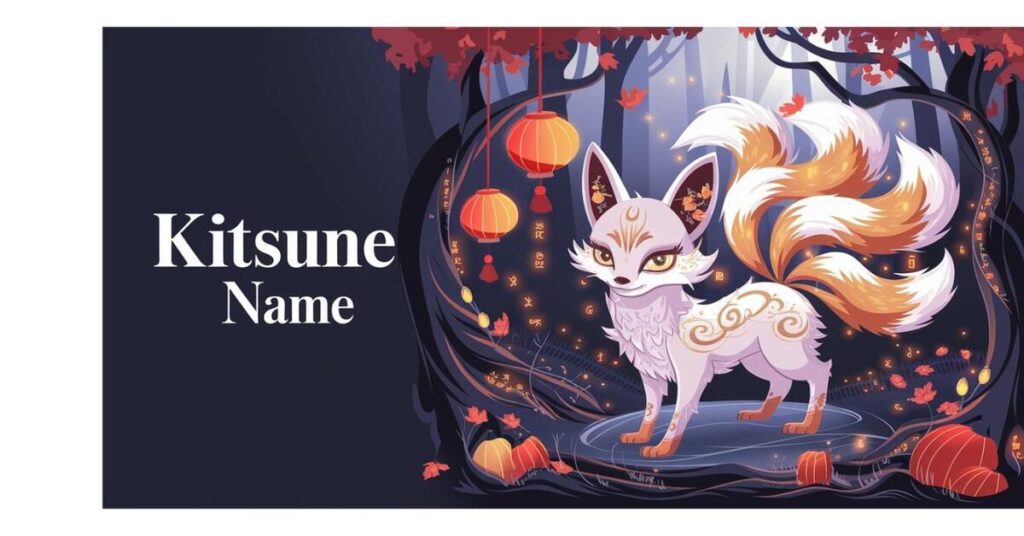Explore the mystical world of Kitsune with our Kitsune Names & Generator for Creative Minds. This guide blends traditional and unique names, each capturing the magic and allure of these legendary fox spirits.
Whether for a story, game, or personal project, the right name can make all the difference. With our curated list and generator, you’ll create a Kitsune character that’s both memorable and meaningful. Let the adventure begin!
Our easy-to-use generator helps you find the perfect name that aligns with your Kitsune’s personality and powers. Let your creativity shine as you bring your Kitsune to life!
Best Kitsune Names
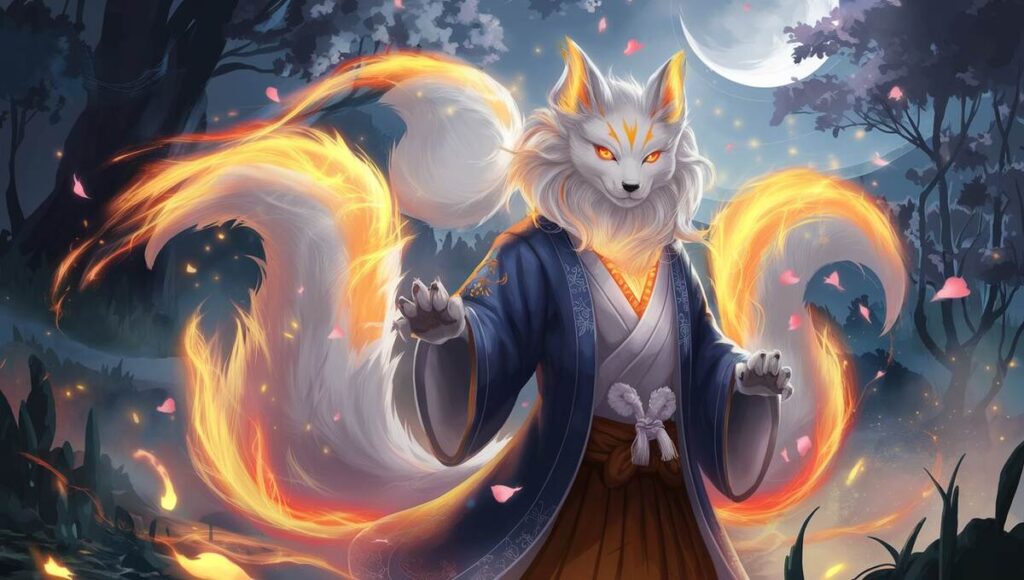
The perfect Kitsune name blends magic, beauty, and strength. These Best Kitsune Names are selected for their deep meaning and connection to the mythical essence of the Kitsune, ensuring your character stands out with a memorable and powerful identity.
- Aiko – “Love and child,” symbolizing affection, warmth, and a kind-hearted spirit.
- Hikaru – Meaning “radiance,” this name reflects wisdom and enlightenment, a bright soul.
- Ryuji – “Dragon child,” representing strength, leadership, and a fierce protector.
- Emi – “Beautiful blessing,” signifying grace and fortune, bringing beauty to others’ lives.
- Yuki – “Snow,” symbolizing purity, clarity, and serenity, often seen as calm and wise.
- Kaito – “Ocean and wisteria,” reflecting depth and beauty, grounded in nature.
- Sora – “Sky,” representing freedom, expansiveness, and a limitless spirit.
- Daiki – “Great brightness,” signifying wisdom, enlightenment, and guiding others.
- Kaori – “Fragrance,” symbolizing beauty, renewal, and delicate charm.
- Haruto – “Sun and man,” representing strength, leadership, and radiant energy.
- Mio – “Beautiful cherry blossom,” symbolizing elegance, vitality, and renewal.
- Renjiro – “Lotus cherry blossom field,” reflecting purity, grace, and resilience.
- Riku – “Land,” representing stability, grounding, and unwavering resilience.
- Aya – “Colorful,” symbolizing vibrancy, joy, and an energetic spirit.
- Shiro – “White,” representing purity, nobility, and noble ideals.
- Fumio – “Scholarly hero,” signifying wisdom, courage, and strength of character.
- Yuna – “Gentle and blessing,” reflecting kindness and a nurturing spirit.
- Tatsuya – “Dragon village,” symbolizing strength, balance, and leadership.
- Saki – “Blossom,” representing renewal, beauty, and positive change.
- Kenshin – “Humble truth,” symbolizing integrity, wisdom, and a strong moral compass.
- Takashi – “Noble and abundant,” reflecting prosperity, honor, and leadership.
- Hina – “Light and blessing,” signifying warmth, radiance, and protection.
- Mika – “New moon and blue,” symbolizing mystery, tranquility, and calmness.
- Koji – “Little second son,” representing youthful vitality, power, and promise.
- Izumi – “Spring,” symbolizing renewal, life, and natural beauty.
- Natsumi – “Summer beauty,” representing warmth, grace, and fiery energy.
- Shinobu – “Endurance,” signifying resilience, strength, and unwavering determination.
- Taro – “Eldest son,” symbolizing leadership, responsibility, and protection.
- Kuro – “Black,” representing depth, mystery, and introspection.
- Airi – “Love and hope,” symbolizing kindness, optimism, and a bright spirit.
- Seiji – “Lawful generosity,” signifying justice, kindness, and a sense of moral duty.
- Takumi – “Skill,” symbolizing craftsmanship, precision, and mastery.
- Yoshiro – “Righteous son,” representing virtue, respect, and integrity.
- Kazuto – “Harmony and excellence,” symbolizing balance, peace, and perfection.
- Emiko – “Blessed child,” signifying fortune, resilience, and joy.
- Haruna – “Spring and lily,” representing renewal, beauty, and purity.
- Chiyo – “Thousand generations,” symbolizing longevity, timeless beauty, and wisdom.
- Hoshiko – “Star child,” reflecting guidance, hope, and light.
- Reiko – “Spirit fox,” symbolizing mystery and magical guidance between realms.
- Kiko – “Joyful fox,” representing happiness, energy, and a charming personality.
Pathfinder Kitsune Names
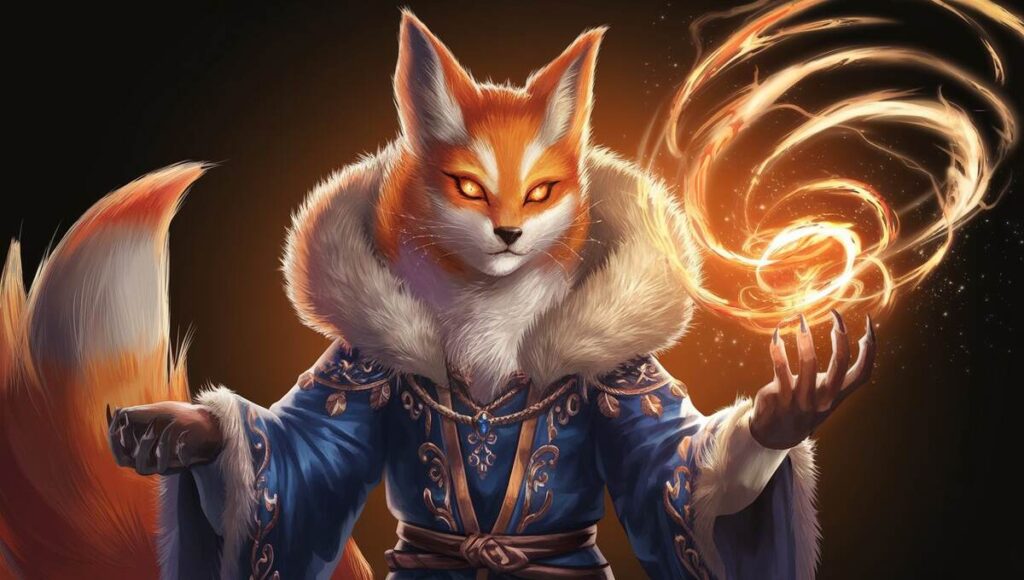
Pathfinder characters need names that reflect their adventurous and magical nature. These Pathfinder Kitsune Names are tailored to fit the unique qualities of Kitsune within the game, blending mythology with the creativity of role-playing.
- Ryuji Mizuhara – Named for “dragon water plains,” symbolizing a fierce and adaptable spirit.
- Hikaru Yamamoto – Meaning “radiant base of the mountain,” representing wisdom and stability.
- Tatsuya Nakamura – “Dragon central village,” symbolizing leadership and balance.
- Shiro Takahashi – Meaning “white high bridge,” representing purity and connection.
- Kaito Fujimoto – “Ocean wisteria base,” symbolizing depth and beauty.
- Daiki Kurosawa – “Great black swamp,” reflecting strength and mystery.
- Riku Sakamoto – “Land hill base,” symbolizing grounded resilience.
- Hayate Inoue – “Swift above the well,” representing speed and insight.
- Kuro Shimizu – “Black clear water,” symbolizing mystery and transparency.
- Yamato Watanabe – “Great harmony crossing the river,” reflecting unity and transition.
- Kenji Matsuda – “Strong pine tree field,” symbolizing endurance and stability.
- Toru Ishikawa – “Penetrating stone river,” representing clarity and strength.
- Haruto Tanaka – “Sun center of the field,” symbolizing light and balance.
- Sora Kobayashi – “Sky small forest,” reflecting openness and protection.
- Naoki Saito – “Honest purifying wisteria,” symbolizing integrity and beauty.
- Yoshiro Suzuki – “Righteous bell tree,” representing virtue and harmony.
- Akira Yamada – “Clarity mountain rice field,” symbolizing vision and abundance.
- Shin Hoshino – “True star field,” reflecting authenticity and brilliance.
- Koji Murakami – “Little upper village,” symbolizing youth and leadership.
- Ryoichi Ogasawara – “Excellent small bamboo field,” representing distinction and growth.
- Takumi Nishimura – “Skill western village,” symbolizing craftsmanship and exploration.
- Haruhiro Okamoto – “Spring hill base,” reflecting renewal and stability.
- Kenshin Yoshida – “Humble good rice field,” symbolizing modesty and prosperity.
- Seiji Miyazaki – “Lawful shrine cape,” representing justice and spirituality.
- Yuji Hasegawa – “Courageous long river,” symbolizing bravery and endurance.
- Renjiro Sakuraba – “Lotus cherry blossom field,” reflecting purity and beauty.
- Daigo Kanzaki – “Great divine cape,” symbolizing wisdom and guidance.
- Takashi Igarashi – “Noble fifty storms,” representing honor and resilience.
- Kazuto Takeda – “Harmonious bamboo field,” symbolizing balance and strength.
- Fumio Nakanishi – “Scholarly hero central west,” reflecting knowledge and balance.
- Rikuo Aoyama – “Land hill mountain,” symbolizing steady growth and ambition.
- Junpei Nakanishi – “Pure second son,” reflecting wisdom and family loyalty.
- Tetsuo Matsumoto – “Iron pine tree,” symbolizing strength and perseverance.
- Shinjiro Fukuda – “True second son,” representing reliability and clarity.
- Kentarou Akiyama – “Big warrior mountain,” symbolizing bravery and protection.
- Hiroki Watanabe – “Generous tree,” reflecting warmth and leadership.
- Ichiro Tsuchiya – “First son of the earth,” symbolizing power and roots.
- Kiyoshi Mori – “Pure forest,” representing protection and sanctity.
- Ryouhei Kuroda – “Cool and calm,” symbolizing peace and serenity.
- Isamu Yamashita – “Courageous mountain,” reflecting strength and valor.
Male Kitsune Names
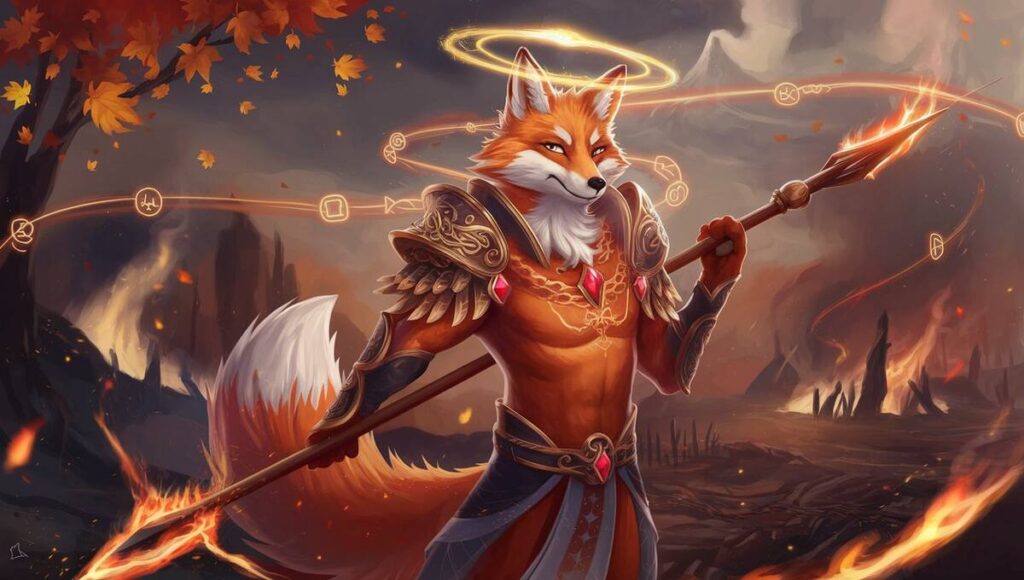
Kitsune can embody many characteristics, from cunning to wisdom. These Male Kitsune Names are chosen to reflect strength, intelligence, and the captivating power of male Kitsune characters in folklore and fantasy settings.
- Ryuji – Named for the dragon and harmony, symbolizing a powerful and balanced spirit.
- Hikaru – Meaning “radiant wisdom,” reflecting intelligence and enlightenment.
- Tatsuya – Named for the dragon and love, symbolizing strength and compassion.
- Shiro – Meaning “white hero,” representing purity, bravery, and integrity.
- Kaito – Named after the ocean and spring, symbolizing vastness, renewal, and clarity.
- Daiki – Meaning “great brightness and harmony,” reflecting a luminous and balanced nature.
- Riku – Named for the land and ascent, symbolizing a grounded yet aspiring spirit.
- Hayate – Meaning “swift second son,” representing speed, agility, and familial strength.
- Kuro – Named for the color black and philosophy, symbolizing depth, mystery, and thoughtfulness.
- Yamato – Meaning “great harmony and prosperity,” reflecting unity and success.
- Kenji – Named for the strong second son and thunder, symbolizing strength, courage, and power.
- Toru – Meaning “penetrating purity,” representing clarity and insight.
- Haruto – Named for the sun and victory, symbolizing light, triumph, and success.
- Sora – Meaning “sky sincerity,” reflecting openness, honesty, and boundless freedom.
- Naoki – Named for the honest tree and scholarly hero, symbolizing integrity and wisdom.
- Yoshiro – Meaning “righteous son and respect,” representing virtue and honor.
- Akira – Named for clarity and ambition, symbolizing vision, drive, and clarity of purpose.
- Shin – Meaning “true purity,” reflecting authenticity and clarity.
- Koji – Named for the little second son and dragon, symbolizing youth, power, and potential.
- Ryoichi – Meaning “excellent first son and strong,” representing distinction, strength, and leadership.
- Takumi – Named for skill and soar, symbolizing craftsmanship, ambition, and talent.
- Haruhiro – Meaning “spring and discipline,” reflecting renewal, growth, and order.
- Kenshin – Named for humble truth and eldest son, symbolizing modesty, wisdom, and leadership.
- Seiji – Meaning “lawful generosity,” representing justice, kindness, and fairness.
- Yuji – Named for the courageous second son and clear, symbolizing bravery and transparency.
- Renjiro – Meaning “lotus second son and independence,” reflecting purity, self-reliance, and growth.
- Daigo – Named for the great enlightenment and harbor, symbolizing wisdom, guidance, and safety.
- Takashi – Meaning “noble and abundant,” representing honor, plenty, and prosperity.
- Kazuto – Named for harmony and excellence, symbolizing balance, distinction, and peace.
- Fumio – Meaning “scholarly hero and second son,” representing knowledge, growth, and familial strength.
- Masato – Named for true man and generous, symbolizing authenticity, kindness, and strength of character.
- Isamu – Meaning “courage and polite second son,” reflecting bravery, respect, and humility.
- Ichiro – Meaning “first son,” symbolizing leadership and new beginnings.
- Kaito – Named for “ocean and wisteria,” symbolizing beauty, depth, and resilience.
- Jinzo – Meaning “man of wisdom,” symbolizing intellect and resourcefulness.
- Raiden – Named for the thunder god, symbolizing power, strength, and energy.
- Satsuki – Meaning “May,” symbolizing renewal and the beauty of spring.
- Reiji – Meaning “spirit and ruler,” reflecting authority, strength, and spiritual power.
- Yuto – Meaning “brave person,” symbolizing courage, spirit, and valor.
- Ryota – Meaning “big, strong man,” representing physical strength, resilience, and leadership.
Must Watch Our Collection Of Monk Names!
Can you imagine casting spells that make your Illusions irresistible?
With Kitsune magic, your illusions become so enchanting that they’re almost impossible to resist. Their mystical powers allow them to weave spells that captivate and mesmerize, making it easy to manipulate or mislead others.
Female Kitsune Names

The allure of Kitsune also extends to their powerful female counterparts. These Female Kitsune Names evoke elegance, grace, and inner strength, perfect for the fierce and magical female fox spirits of myth and story.
- Aiko – “Love and child,” symbolizing affection and nurturing. A Kitsune filled with warmth and care for others.
- Emi – “Beautiful blessing,” representing grace, charm, and good fortune. A name for a Kitsune who brings joy and beauty to the world.
- Kaori – “Fragrance,” evoking the delicate scent of cherry blossoms. Represents elegance, subtle beauty, and quiet power.
- Hikari – “Light,” symbolizing hope, guidance, and illumination. A Kitsune who brings clarity and insight to others.
- Natsumi – “Summer beauty,” representing warmth, vitality, and elegance. A lively and graceful Kitsune who embodies the spirit of summer.
- Yuki – “Snow,” reflecting purity, calmness, and serenity. A Kitsune who brings peace and clarity during difficult times.
- Mio – “Beautiful cherry blossom,” symbolizing renewal and the beauty of life. Represents grace and fleeting beauty.
- Aya – “Colorful,” representing vibrancy, creativity, and diversity. A Kitsune who adds energy and color to everything she touches.
- Sora – “Sky,” symbolizing freedom, openness, and endless possibilities. A Kitsune who embodies boundless adventure.
- Arisa – “Bright sand,” symbolizing joy and resilience. A Kitsune who shines with strength even in adversity.
- Chiyo – “Thousand generations,” symbolizing wisdom and longevity. A name for a Kitsune with deep knowledge and historical roots.
- Eri – “Blessed prize blossom,” representing beauty, fortune, and a cherished life. A Kitsune who brings blessings and prosperity.
- Yuna – “Gentle,” symbolizing kindness, compassion, and grace. A peaceful and soft-hearted Kitsune who helps heal others.
- Kasumi – “Mist,” symbolizing mystery and allure. A Kitsune with an enigmatic presence, guiding others with subtle wisdom.
- Koharu – “Small spring,” symbolizing youth, fluidity, and new beginnings. A Kitsune who brings refreshing energy to those around her.
- Rina – “Jasmine,” symbolizing beauty, sweetness, and elegance. A Kitsune who captivates with her delicate and enchanting charm.
- Airi – “Love and hope,” reflecting affection and aspiration. A Kitsune who inspires others with her love and optimism.
- Riko – “Jasmine child,” symbolizing purity and wisdom. A Kitsune who combines beauty with knowledge and grace.
- Haruna – “Spring and lily,” symbolizing renewal and purity. A Kitsune whose spirit is as fresh and rejuvenating as spring.
- Yui – “Tie and beautiful moon,” representing connection and elegance. A Kitsune who binds people together with grace and beauty.
- Emiko – “Blessed child,” symbolizing joy and resilience. A name for a Kitsune who brings happiness and hope to others.
- Izumi – “Spring water,” symbolizing clarity and life-giving energy. A Kitsune who offers purification and calm to troubled souls.
- Akari – “Light,” symbolizing guidance and new beginnings. A Kitsune who illuminates the path for others to follow.
- Mai – “Dance,” representing joy, movement, and celebration. A Kitsune who spreads joy and elegance wherever she goes.
- Ayumi – “Walk and companion,” symbolizing progress and friendship. A Kitsune who supports others through their journeys with loyalty.
- Kiyomi – “Pure beauty,” symbolizing grace and inner peace. A Kitsune who radiates elegance and serenity from within.
- Hina – “Light,” representing radiance and fortune. A Kitsune whose gentle presence brings brightness to the darkest places.
- Nao – “Honest,” symbolizing integrity and sincerity. A Kitsune known for her truthfulness and moral clarity.
- Reina – “Wise and snow,” symbolizing intelligence and tranquility. A Kitsune who offers wisdom and calm insight during times of uncertainty.
- Mika – “New moon,” symbolizing mystery and transformation. A Kitsune who ushers in change with quiet strength and elegance.
- Saki – “Blossom,” symbolizing beauty and growth. A Kitsune who inspires new beginnings and the flourishing of life.
- Nozomi – “Hope,” symbolizing dreams and aspirations. A Kitsune who encourages others to reach for their goals and keep moving forward.
- Maya – “True arrow,” representing direction and focus. A Kitsune who helps others find their path with clarity and precision.
- Hoshiko – “Star child,” symbolizing guidance and light. A Kitsune who shines brightly, offering wisdom and direction to lost souls.
- Sora Umi – “Sky and sea,” symbolizing adventure and freedom. A Kitsune who embraces life’s limitless possibilities with open arms.
- Miki – “Beautiful tree,” symbolizing strength and growth. A Kitsune who provides stability and protection to those she loves.
- Rika – “True fragrance,” symbolizing purity and charm. A Kitsune who enchants others with her elegance and graceful presence.
- Risa – “Village princess,” symbolizing royal charm and grace. A Kitsune who leads with kindness and commands respect through her wisdom.
- Kira – “Glitter,” symbolizing sparkle and allure. A Kitsune who captivates with her charm, leaving a trail of brilliance wherever she goes.
- Nana – “Seven stars,” symbolizing brilliance and dreams. A Kitsune who lights the way with her cosmic energy and inspirational presence.
Kitsune Last Names

Last names often carry deep significance in both myth and fantasy. These Kitsune Last Names offer a wide range of options, each reflecting the Kitsune’s heritage, nature, or mystical connection to the world around them.
- Mizuhara – “Water plains,” symbolizing a Kitsune’s adaptability and tranquility, like a river that flows smoothly through all obstacles.
- Yamamoto – “Base of the mountain,” reflecting a solid foundation and inner strength, standing firm against any challenge.
- Nakamura – “Central village,” representing harmony, community, and balance, with a Kitsune serving as the heart of their group.
- Takahashi – “High bridge,” signifying a connection between worlds, guiding others with wisdom across life’s challenges.
- Fujimoto – “Wisteria base,” embodying elegance, beauty, and resilience, much like the graceful wisteria flower that climbs high.
- Kurosawa – “Black swamp,” reflecting mystery and depth, suggesting a Kitsune with untapped wisdom and hidden powers.
- Sakamoto – “Hill base,” symbolizing grounded stability and strength, representing a Kitsune who supports and uplifts others.
- Inoue – “Above the well,” indicating clarity and insight, representing a Kitsune with an elevated view of the world around them.
- Shimizu – “Clear water,” symbolizing purity and transparency, reflecting a Kitsune who is honest and straightforward in their dealings.
- Watanabe – “Crossing the river,” symbolizing a journey or transition, representing a Kitsune who helps others navigate life’s changes.
- Matsuda – “Pine tree field,” representing endurance and resilience, much like a pine tree that stands tall through all seasons.
- Ishikawa – “Stone river,” embodying a perfect blend of strength and adaptability, as a Kitsune who faces challenges with both power and grace.
- Tanaka – “Center of the field,” signifying balance, growth, and fertility, representing a Kitsune who fosters harmony wherever they go.
- Kobayashi – “Small forest,” symbolizing modesty, protection, and quiet strength, reflecting a Kitsune who thrives in the shadows.
- Saito – “Purifying wisteria,” signifying spiritual beauty and cleansing, representing a Kitsune who brings peace and restoration to their environment.
- Suzuki – “Bell tree,” symbolizing resonance and harmony, like the calming sound of a bell that brings clarity to all who hear it.
- Yamada – “Mountain rice field,” representing prosperity and resilience, signifying a Kitsune who nourishes both body and spirit.
- Hoshino – “Star field,” symbolizing brilliance, aspiration, and guidance, much like a Kitsune who leads others to their destiny.
- Murakami – “Upper village,” representing leadership and wisdom, reflecting a Kitsune who guides their community with grace and foresight.
- Ogasawara – “Small bamboo field,” symbolizing flexibility and growth, representing a Kitsune who adapts to the changing tides of life.
- Nishimura – “Western village,” signifying exploration and openness, representing a Kitsune with a curious and adventurous spirit.
- Okamoto – “Hill base,” reflecting grounded stability and unwavering support, like a Kitsune who provides strength to those around them.
- Yoshida – “Good rice field,” symbolizing abundance, prosperity, and fertility, representing a Kitsune who nurtures growth in all things.
- Miyazaki – “Shrine cape,” symbolizing protection, reverence, and spirituality, representing a Kitsune who safeguards sacred places.
- Hasegawa – “Long river,” symbolizing continuity, endurance, and a steady flow, like a Kitsune whose influence lasts through the ages.
- Sakuraba – “Cherry blossom field,” representing beauty, renewal, and fleeting moments, symbolizing a Kitsune who brings change and transformation.
- Kanzaki – “Divine cape,” symbolizing spirituality and sacred guidance, representing a Kitsune who offers wisdom and divine protection.
- Igarashi – “Fifty storms,” reflecting power, strength, and resilience, like a Kitsune who stands strong in the face of adversity.
- Takeda – “Bamboo field,” symbolizing strength and flexibility, representing a Kitsune who bends but never breaks under pressure.
- Aozora – “Blue sky,” representing freedom, clarity, and the vastness of possibility, like a Kitsune who sees beyond the horizon.
- Kaminari – “Thunder,” symbolizing raw power and energy, reflecting a Kitsune who commands respect and wields great force.
- Yukimura – “Snow village,” symbolizing purity, serenity, and quiet strength, reflecting a Kitsune who brings calm in turbulent times.
- Raikou – “Thunder light,” representing sudden illumination and force, like a Kitsune who strikes with clarity and precision.
- Tetsuya – “Iron valley,” symbolizing unyielding strength and determination, reflecting a Kitsune who is resolute and unwavering in their goals.
- Mikazuki – “Crescent moon,” representing mystery and subtle power, like a Kitsune who has a quiet but powerful presence.
- Fujibayashi – “Wisteria forest,” symbolizing beauty and natural elegance, representing a Kitsune who thrives in peaceful, harmonious surroundings.
- Hokuto – “Northern star,” signifying guidance, direction, and purpose, like a Kitsune who leads others toward their true path.
- Ginkawa – “Silver river,” symbolizing wisdom and tranquility, reflecting a Kitsune who offers peace and clarity to all they encounter.
- Asahikawa – “Morning river,” symbolizing renewal, hope, and new beginnings, like a Kitsune who brings light after darkness.
- Suiren – “Water lily,” symbolizing grace, resilience, and beauty, representing a Kitsune who blooms even in difficult circumstances.
Dungeons & Dragons (DnD) Kitsune Names
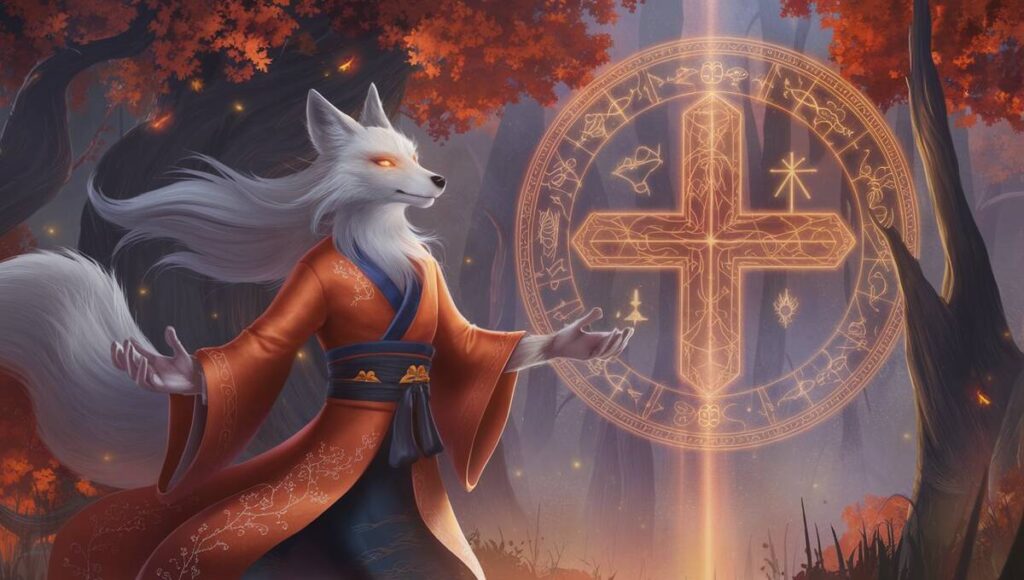
Kitsune are full of mystery and magic in Dungeons & Dragons. These Dungeons & Dragons (DnD) Kitsune Names are designed to bring out the mystical, powerful traits of Kitsune, perfect for creating a character with unique abilities and a rich backstory.
- Reiko Aozora – “Clear sky,” symbolizing clarity and guidance, representing a Kitsune who helps others find their path.
- Kaito Tsukishiro – “Ocean and white moon,” reflecting a Kitsune with control over tides and illusions.
- Mio Hoshizora – “Beautiful starry sky,” representing a Kitsune skilled in navigation and astrology, leading with brilliance.
- Haruto Kagemaru – “Sun and shadow,” symbolizing duality and balance, a Kitsune who walks between light and darkness.
- Sora Yumehana – “Sky and dream flower,” reflecting a Kitsune with the power to manipulate dreams and heal others.
- Akira Kaminari – “Clarity and thunder,” signifying a Kitsune with the power over lightning, striking with precision.
- Yuki Kazemori – “Snow and wind forest,” representing a Kitsune with control over both ice and wind, calm yet powerful.
- Taro Shinsei – “Eldest son and new star,” symbolizing leadership and the birth of new power, a Kitsune destined for greatness.
- Aiko Hanazuki – “Love and flower moon,” representing a Kitsune who enchants and protects with beauty and affection.
- Natsu Hikari – “Summer and light,” signifying a radiant personality, spreading warmth and positivity wherever they go.
- Rin Kaedehara – “Companion and maple field,” symbolizing loyalty and earthy power, representing a Kitsune in tune with nature.
- Takumi Tenryu – “Skilled and heavenly dragon,” signifying mastery over crafts and celestial forces, a Kitsune with divine abilities.
- Kiyoshi Mizuno – “Purity and water field,” symbolizing healing and cleansing, representing a Kitsune with restorative powers.
- Emi Sora – “Beautiful blessing and sky,” reflecting a Kitsune with a protective nature, offering grace and guidance to others.
- Daiki Fujikawa – “Great brightness and wisteria river,” representing a Kitsune whose power flows with grace and clarity.
- Hana Midori – “Flower and green,” symbolizing renewal and vitality, a Kitsune who brings nature back to life.
- Shinobu Kurokaze – “Endurance and black wind,” reflecting a Kitsune who thrives in the darkest of times, enduring and mysterious.
- Aoi Yamashita – “Blue and mountain base,” signifying serenity, wisdom, and an unwavering foundation in the natural world.
- Hikaru Seiryu – “Radiant and blue dragon,” symbolizing brilliance and elemental mastery, a Kitsune with dragon-like strength.
- Riku Amano – “Land and heavenly field,” representing balance between earth and sky, with powers to manipulate both realms.
- Aya Hoshino – “Colorful and star field,” symbolizing a vibrant, radiant Kitsune whose energy lights up the darkest places.
- Naoki Komatsu – “Honest and small pine,” representing integrity and protection, a Kitsune who stands tall despite being small.
- Sakura Hinata – “Cherry blossom and sunny place,” reflecting a Kitsune with a gentle, nurturing spirit, bringing warmth and light.
- Tatsuo Raiden – “Dragon and thunder,” symbolizing power, intensity, and a Kitsune with dominion over storms and dragons.
- Yuna Mizuki – “Gentle and beautiful moon,” representing serenity, calmness, and a Kitsune with lunar magic.
- Kenshin Akimoto – “Humble truth and autumn base,” symbolizing wisdom, modesty, and an understanding of seasonal cycles.
- Reina Yagami – “Wise and night god,” reflecting a Kitsune with deep intelligence and control over night-based magic.
- Isamu Ren – “Courage and lotus,” symbolizing bravery and spiritual connections, a Kitsune whose courage inspires others.
- Renjiro Sakuraba – “Lotus and cherry blossom field,” representing purity, beauty, and a Kitsune with a calm yet commanding presence.
- Shiro Tanaka – “White and central field,” symbolizing purity, neutrality, and a Kitsune who brings balance to all situations.
- Hiroshi Tetsuya – “Generous and iron valley,” representing strength, reliability, and a Kitsune whose resolve is as strong as iron.
- Kaito Shimizu – “Ocean and clear water,” symbolizing adaptability and purity, a Kitsune whose powers flow with grace and clarity.
- Tomo Akechi – “Wise companion and bright wisdom,” symbolizing a Kitsune with a keen mind and loyal spirit, a true ally in any adventure.
- Sachi Hana – “Blessed and flower,” reflecting a Kitsune with a nurturing and protective nature, bringing good fortune and beauty.
- Yoshiro Fujimoto – “Righteous and wisteria base,” representing virtue, balance, and a Kitsune deeply rooted in tradition and wisdom.
- Kouji Harukaze – “Little second son and spring wind,” symbolizing youth, renewal, and a Kitsune with a breezy, carefree personality.
- Ryoichi Ishida – “Excellent first son and stone,” representing leadership, resilience, and a Kitsune with a foundation of rock-solid integrity.
- Seiji Okamoto – “Lawful shrine cape,” symbolizing justice and protection, a Kitsune with a strong sense of duty and divine purpose.
- Akira Yamada – “Clarity and mountain rice field,” symbolizing insight, growth, and a Kitsune whose wisdom nurtures prosperity.
- Keiko Inoue – “Blessed child and above the well,” representing purity, spiritual insight, and a Kitsune who brings blessings to those around them.
Discover Our Collection Of Ghost Names!
Did you know you can shift between human and fox to outwit your enemies?
Kitsune have the ability to shape-shift, using their cunning to seamlessly transition between human and fox forms. This skill gives them a tactical advantage, allowing them to deceive and outsmart their enemies with ease.
Mythology Kitsune Names

Kitsune are important figures in Japanese mythology, linked to divine forces and nature. These Mythology Kitsune Names are inspired by ancient legends, giving your Kitsune character a deep, mystical connection to folklore.
- Osaki – A Kitsune known for protecting homes and ensuring prosperity, symbolizing guardianship and care.
- Tamamo – Derived from the famous Tamamo-no-Mae, a powerful Kitsune who served as a courtesan, representing beauty and cunning.
- Shou – A wise Kitsune associated with longevity and good fortune, symbolizing wisdom and long life.
- Ojiro – A fox spirit with a large, bushy tail, representing wealth and abundance in Japanese folklore.
- Miketsu – A fox deity of food and agriculture, ensuring bountiful harvests, symbolizing fertility and nourishment.
- Kokuzo – A black Kitsune spirit known for mystery and the supernatural, representing hidden knowledge and secrets.
- Gyokuto – A celestial fox linked to the moon, symbolizing beauty, the night, and elusive power.
- Chikiri – A wish-granting fox spirit, known for fulfilling desires, symbolizing benevolence and magic.
- Seiran – A fox associated with good weather and clear skies, representing clarity, tranquility, and favorable omens.
- Hoshiko – A star fox, guiding lost souls and offering hope, symbolizing light in darkness and direction.
- Sorano – A sky fox, often seen as a messenger between realms, symbolizing freedom and transcendence.
- Reiko – A Kitsune who intervenes in human affairs, sometimes helping and sometimes hindering, representing change and unpredictability.
- Kazeno – A wind fox, known for its swift movements and transformative nature, symbolizing change and power.
- Yukiko – A snow fox, associated with purity, cold beauty, and winter, symbolizing serenity and stillness.
- Mizuko – A water fox, symbolizing adaptability and protection, often seen guarding rivers and lakes.
- Hanako – A flower fox, known for its delicate beauty, symbolizing grace, charm, and the fleeting nature of life.
- Tatsuko – A dragon fox, signifying strength and protection, symbolizing the fierce and loyal qualities of a guardian spirit.
- Hikari – A light fox, known for guiding the lost and illuminating the way, representing enlightenment and guidance.
- Aonoko – A blue fox, symbolizing tranquility and peace, often depicted in stories involving harmony and calm.
- Suzu – A bell fox, whose chimes bring joy and festivity, symbolizing happiness, celebration, and clarity.
- Yamiko – A darkness fox, associated with mystery and the unknown, representing the shadowy aspects of nature.
- Hinoko – A fire fox, symbolizing passion, energy, and destruction, linked to powerful, transformative events.
- Kagura – A dance fox, often seen in festivals, symbolizing joy, celebration, and the vitality of life.
- Kiko – A joyful fox, bringing happiness and good fortune, symbolizing cheerfulness and positive energy.
- Tsukiko – A moon child fox, embodying the mystical and magical aspects of the night, symbolizing mystery and beauty.
- Yume – A dream fox, representing the manipulation of dreams and the bridge between the conscious and the unconscious.
- Inari – A fox spirit linked to the deity Inari, representing abundance, fertility, and protection of the harvest.
- Nogitsune – A wild fox spirit known for its trickery and mischief, symbolizing cunning and unpredictability.
- Zenko – A benevolent fox spirit, often associated with the Inari shrines, representing purity, protection, and guidance.
- Koryo – An ancient fox spirit, symbolizing wisdom and teachings from the past, often imparting knowledge to the deserving.
- Shakko – A red fox, often linked to fire, symbolizing passion, vitality, and strength.
- Byakko – A white fox, representing purity and protection, often a guardian spirit associated with good fortune.
- Ginko – A Kitsune named after the ginkgo tree, symbolizing resilience and longevity, often linked to endurance.
- Rin – A Kitsune associated with the “wheel of life,” symbolizing the cycle of life, death, and rebirth.
- Shinko – A divine fox spirit linked to rebirth and new beginnings, symbolizing renewal and fresh starts.
- Myobu – A fox spirit messenger of the deity Inari, known for its divine communication and spiritual insight.
- Akaiko – A red fox spirit, representing vitality, energy, and the heart’s desires, often linked to enthusiasm and joy.
- Yako – Known as the field fox, associated with rural landscapes, symbolizing the protection of farmland and natural growth.
- Kitsune-no-Kage – “Shadow of the Kitsune,” symbolizing secrecy, transformation, and stealth, a fox spirit with the power of illusion.
- Akai – A fox associated with the color red, representing vitality, love, and the passionate force that drives the Kitsune spirit.
Good Kitsune Names
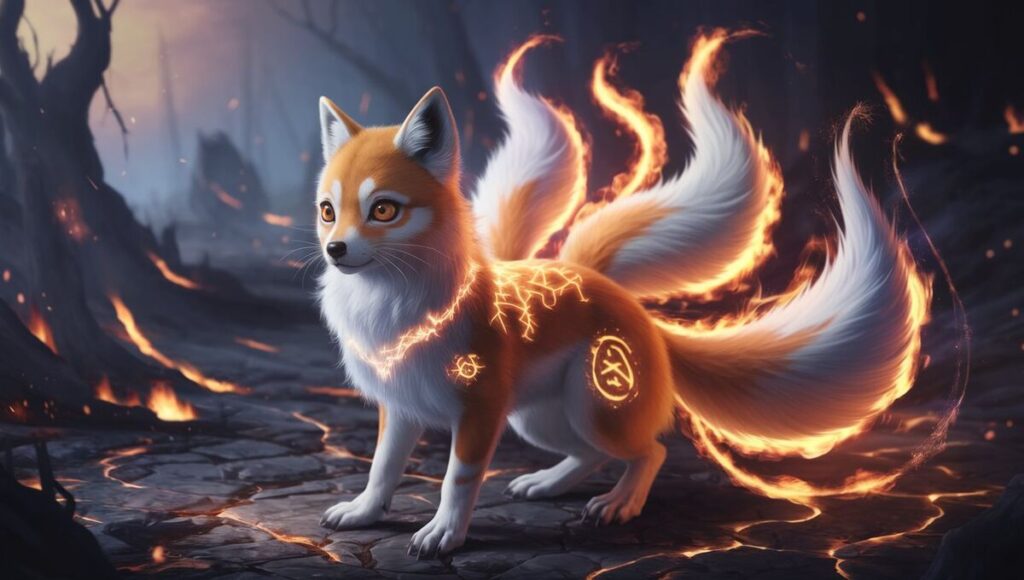
Kitsune aren’t just tricksters—they can be protectors and healers too. These Good Kitsune Names reflect the qualities of kindness, loyalty, and strength, perfect for a benevolent Kitsune who serves as a guardian to those in need.
- Aiko Mizuno – “Love and water field,” symbolizing a nurturing and healing spirit, always bringing peace and calm.
- Hikari Yume – “Light and dream,” representing clarity, hope, and a guiding force through dark times.
- Emiko Sora – “Blessed child and sky,” signifying grace, protection, and a celestial connection to all beings.
- Takumi Midori – “Skilled and green,” symbolizing growth, wisdom, and the ability to nurture and create.
- Reina Hinata – “Wise and sunny place,” reflecting warmth, wisdom, and a spirit that brightens the lives of others.
- Kaito Aozora – “Ocean and blue sky,” symbolizing vastness, tranquility, and the calming power of nature.
- Yuna Hanabi – “Gentle and fireworks,” representing joy, celebration, and the ability to bring light and beauty to the world.
- Shiro Amaya – “White and night rain,” symbolizing purity, cleansing, and the quiet strength that comes with renewal.
- Sakura Hoshino – “Cherry blossom and star field,” representing beauty, guidance, and a connection to the celestial.
- Haruto Seiryu – “Sun and blue dragon,” symbolizing radiant energy, protection, and strength in times of need.
- Aya Takahashi – “Colorful and high bridge,” reflecting a Kitsune who unites people with harmony, wisdom, and balance.
- Daiki Fujimoto – “Great brightness and wisteria base,” symbolizing enlightenment, peace, and natural beauty.
- Hana Yukino – “Flower and snow field,” representing grace, tranquility, and the ability to bring calm to chaotic surroundings.
- Kiyoshi Matsuda – “Purity and pine field,” symbolizing clarity, honesty, and a steadfast protector of nature.
- Rin Asahi – “Companion and morning sun,” representing loyalty, hope, and a refreshing new start each day.
- Sora Kaminari – “Sky and thunder,” symbolizing a gentle yet powerful force, protecting and guiding others with strength.
- Yuki Kazemaru – “Snow and wind circle,” reflecting adaptability, balance, and the ability to bring calm in turbulent times.
- Taro Hoshizora – “Eldest son and starry sky,” symbolizing leadership, wisdom, and a guiding presence for others.
- Aoi Yamashita – “Blue and mountain base,” representing grounded wisdom, serenity, and a steadfast protector.
- Hikaru Amano – “Radiant and heavenly field,” symbolizing divine protection, brilliance, and purity of heart.
- Riku Kurokawa – “Land and black river,” symbolizing strength, resilience, and the ability to stand firm in the face of adversity.
- Naoki Hanazono – “Honest and flower garden,” symbolizing integrity, beauty, and the nurturing of others with kindness.
- Isamu Ren – “Courage and lotus,” reflecting bravery, spiritual growth, and the ability to bloom in difficult conditions.
- Akira Mizuki – “Clarity and beautiful moon,” symbolizing enlightenment, serenity, and the wisdom that comes with peace.
- Kenshin Yagami – “Humble truth and night god,” representing wisdom, humility, and the ability to bring peace even in the darkest times.
- Yoshiko Tsubaki – “Righteous child and camellia,” symbolizing virtue, beauty, and the power to protect those in need.
- Shinobu Arashi – “Endurance and storm,” representing resilience, inner strength, and the ability to weather any challenge.
- Keiko Inoue – “Blessed child and above the well,” symbolizing purity, grace, and a deep spiritual connection with nature.
- Haruki Fujiwara – “Spring and wisteria,” symbolizing renewal, beauty, and a refreshing force for growth and peace.
- Mika Hanami – “New moon and flower viewing,” representing hope, fresh beginnings, and the ability to find beauty in all things.
- Ami Yuki – “Friend and snow,” symbolizing loyalty, friendship, and the gentle power of support through tough times.
- Fumiko Saito – “Scholarly child and wisteria,” representing knowledge, growth, and the nurturing of wisdom in others.
- Reiko Itsuki – “Clear and tree,” symbolizing wisdom, strength, and the enduring support of nature.
- Tatsuya Nobu – “Dragon and faith,” representing strength, devotion, and an unwavering belief in the goodness of all things.
- Izumi Haruno – “Spring and law child,” reflecting purity, renewal, and a deep understanding of nature’s balance.
- Saki Tsubaki – “Blossom and camellia,” symbolizing beauty, grace, and the power of quiet yet resilient strength.
- Nanae Fuyu – “Seven and winter,” symbolizing purity, calm, and the gentle yet powerful presence of winter.
- Emi Sakura – “Beautiful blessing and cherry blossom,” representing charm, good fortune, and the fleeting beauty of life.
- Renjiro Mori – “Lotus second son and forest,” symbolizing purity, growth, and a deep connection to the earth.
- Yumeko Arata – “Dream child and new,” reflecting hope, new beginnings, and the peaceful promise of the future.
Unique Kitsune Names
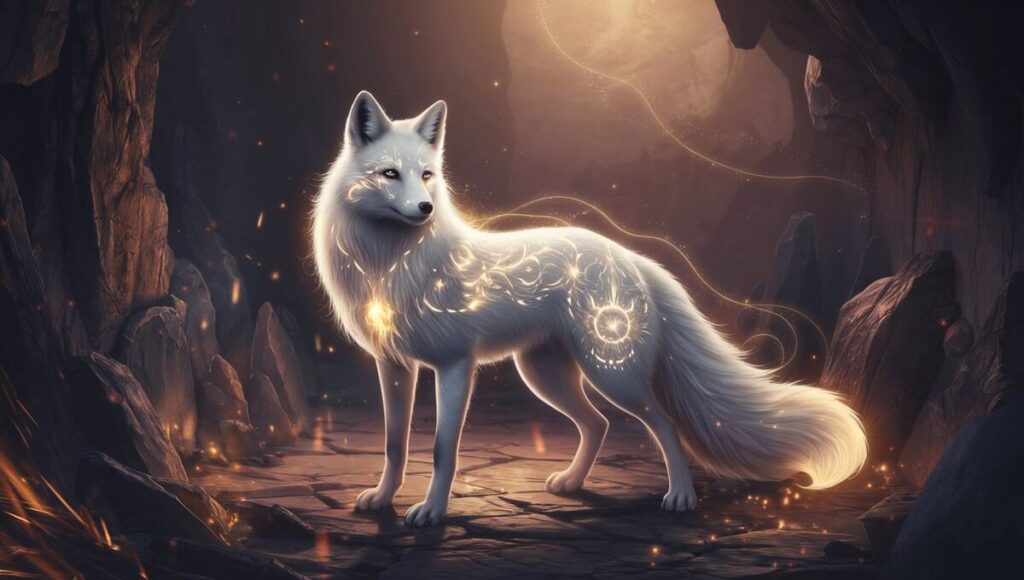
Every Kitsune is special, and their name should reflect that uniqueness. These Unique Kitsune Names are designed to stand out, offering rare, meaningful choices for a character whose powers and personality are truly one of a kind.
- Soraiko – “Sky child,” symbolizing freedom, open possibilities, and a connection to the heavens.
- Aren – “Gift of the moon,” reflecting grace, beauty, and the quiet power of lunar influence.
- Kirinami – “Dragon wave,” representing power, wisdom, and a force that moves through life like a rolling wave.
- Tsukiyo – “Moonlit night,” symbolizing mystery, quiet strength, and illumination in the darkness.
- Reiko – “Graceful spirit,” reflecting beauty, elegance, and a presence that brings peace and calm to all around.
- Raiya – “Thunder night,” symbolizing power, unpredictability, and the force that strikes during the calmest times.
- Mizuki – “Water moon,” symbolizing clarity, reflection, and the ability to bring calm in any storm.
- Takaomi – “Noble protector,” representing strength, leadership, and the responsibility to guide and defend others.
- Yumehiko – “Dream prince,” signifying a Kitsune who guides others through dreams and offers wisdom in sleep.
- Hoshiko – “Star child,” symbolizing guidance, hope, and the light that leads through dark times.
- Kaiyo – “Ocean dream,” representing depth, tranquility, and the vast mysteries of life and the world around.
- Shizune – “Silent breeze,” symbolizing calm, subtle power, and the ability to move through the world unnoticed yet impactful.
- Kiyori – “Pure lily,” reflecting purity, grace, and the delicate yet powerful nature of those who seek peace.
- Ariya – “Noble dawn,” symbolizing new beginnings, hope, and the start of a bright future.
- Tsubaki – “Camellia flower,” representing beauty, resilience, and elegance, with the strength to weather all storms.
- Kazuya – “Peaceful valley,” symbolizing serenity, balance, and the quiet wisdom that comes from stillness.
- Hinata – “Sunny place,” symbolizing warmth, joy, and a nurturing spirit that brightens others’ lives.
- Ryoji – “Refreshing wind,” representing renewal, change, and the ability to bring fresh perspectives.
- Yukino – “Snowy field,” symbolizing purity, stillness, and the quiet power that comes from within.
- Kohaku – “Amber,” representing warmth, light, and a deep, soulful presence that shines through any darkness.
- Aozora – “Blue sky,” symbolizing clarity, freedom, and the limitless possibilities that await ahead.
- Natsuki – “Summer hope,” reflecting warmth, positivity, and the vibrant energy of life in full bloom.
- Seiryu – “Blue dragon,” symbolizing strength, majesty, and the power to protect all that is dear.
- Fujiko – “Wisteria child,” representing grace, beauty, and the delicate nature of blooming under pressure.
- Ryuma – “Dragon horse,” symbolizing fierce determination, strength, and the balance of wisdom and power.
- Rikae – “Clear reflection,” representing honesty, truth, and the purity that comes with understanding oneself.
- Yasuo – “Peaceful man,” symbolizing inner calm, wisdom, and the ability to bring peace wherever one goes.
- Mikumo – “Cloud dream,” reflecting the ethereal, fleeting nature of life and the ability to navigate its complexities.
- Akihiko – “Autumn prince,” symbolizing strength, maturity, and the grace that comes with the passing seasons.
- Takara – “Treasure,” representing the hidden value within, waiting to be discovered and shared with others.
- Sakiya – “Blooming flower,” symbolizing beauty, growth, and the transformative power of nature.
- Fuyuki – “Winter tree,” reflecting resilience, endurance, and the quiet strength to stand tall in harsh conditions.
- Yuriko – “Lily child,” symbolizing beauty, innocence, and the quiet wisdom that comes with simplicity.
- Kazenori – “Wind and forest,” representing freedom, growth, and the ability to flow with the natural world.
- Rinako – “Cold child,” symbolizing purity, stillness, and a calm force that influences the world in subtle ways.
- Hiraku – “To bloom,” representing growth, change, and the willingness to emerge in new forms of strength.
- Torao – “Tiger king,” symbolizing power, nobility, and the strength to lead and protect.
- Kiyomizu – “Pure water,” reflecting clarity, cleansing, and the ability to refresh others with gentle presence.
- Azami – “Thistle,” representing resilience, strength in adversity, and beauty in unexpected places.
- Kaede – “Maple,” symbolizing adaptability, the beauty of change, and the wisdom that comes from transition.
Explore Our Collection Of Knight Names!
Can you imagine a court beauty hiding a secret that could change an empire’s fate?
A Kitsune, disguised as a beautiful court lady, might hide a powerful secret—one that, if revealed, could shake the very foundations of an empire. Their mystical abilities and strategic mind make them masters of secrecy and manipulation.
Famous Kitsune Names
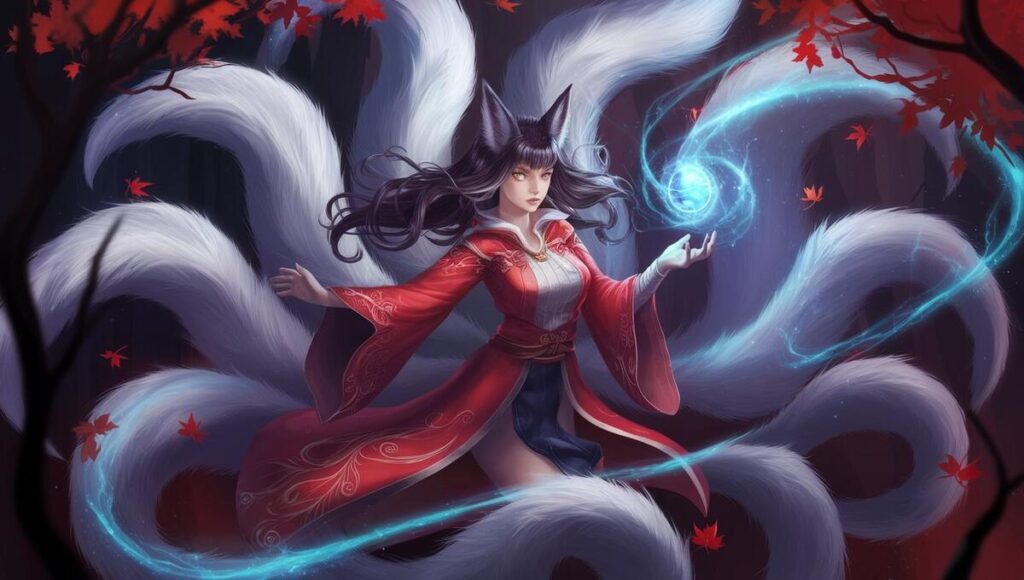
Kitsune have left their mark on Japanese folklore as magical, often legendary creatures. These Famous Kitsune Names are inspired by well-known fox spirits, bringing with them rich histories of wisdom, mischief, and mystery.
- Tamamo-no-Mae – A legendary nine-tailed fox who disguised herself as a courtesan, representing beauty, intelligence, and deception.
- Kuzunoha – A famous Kitsune who transformed into a woman and married a man, symbolizing love, transformation, and the balance between worlds.
- Shiragiku – A Kitsune named after the white chrysanthemum, symbolizing purity and elegance, often associated with gentle spirits.
- Genko – Known as the “Dark Fox,” representing mystery, shadow magic, and the unknown forces in the world.
- Koan – A wise Kitsune who imparted cryptic wisdom, symbolizing deep philosophical insights and the Zen-like nature of Kitsune.
- Tenko – A celestial fox spirit linked to the heavens, symbolizing divine power, benevolence, and protection.
- Komachi – Named after the poet Ono no Komachi, symbolizing artistic beauty, creativity, and the expression of soul through art.
- Hakuzosu – A Buddhist monk Kitsune, representing enlightenment, spiritual growth, and the connection between fox spirits and higher realms.
- Yako – A wild fox spirit, known for its mischievous nature, symbolizing trickery, chaos, and the playful side of Kitsune.
- Zenko – A benevolent fox spirit who helps humans, representing purity, protection, and divine intervention.
- Nogitsune – A wild and trickster Kitsune, symbolizing cunning, unpredictability, and the power of deceit.
- Inari – The deity of rice, fertility, and prosperity, often associated with fox spirits, symbolizing abundance, blessing, and divine protection.
- Koryo – An ancient Kitsune, symbolizing wisdom from the past and spiritual teachings passed down through generations.
- Shakko – The red fox, often linked to fire and passion, symbolizing vitality, strength, and intense energy.
- Byakko – A white fox representing purity, protection, and sacred guardian spirits, often linked to good fortune.
- Ginko – A Kitsune associated with the ginkgo tree, symbolizing resilience, longevity, and the timeless nature of wisdom.
- Rin – A Kitsune associated with the wheel of life, symbolizing cycles, transformation, and rebirth.
- Shinko – A divine fox spirit linked to new beginnings and rebirth, representing spiritual renewal and fresh starts.
- Myobu – A messenger fox of the deity Inari, representing divine communication, spiritual guidance, and the connection between gods and humans.
- Akaiko – A red fox spirit, symbolizing vitality, energy, and the power of transformation through fiery forces.
- Yamiko – A dark fox, often involved in shadowy tales, representing mystery, darkness, and hidden power.
- Hinoko – A fire fox spirit, symbolizing passion, energy, and the transformative power of fire.
- Kagura – A dance fox, representing joy, celebration, and the festive nature of Kitsune, often seen during important events or ceremonies.
- Kiko – A joyful fox spirit, symbolizing happiness, good fortune, and spreading cheer wherever it goes.
- Tsukiko – A moon child fox, representing mystery, beauty, and the connection between the moon’s influence and the spirit world.
- Yume – A dream fox, reflecting the ability to manipulate and guide dreams, symbolizing the bridge between sleep and consciousness.
- Inari Okami – The powerful fox deity, representing rice, prosperity, and a strong spiritual connection with nature.
- Nogitsune – A mischievous, wild Kitsune, representing the chaotic and unpredictable forces that shape fate.
- Koryo – A Kitsune known for its deep wisdom and connection to the spiritual world, symbolizing ancient knowledge.
- Tatsuko – A dragon fox spirit, symbolizing strength, courage, and the protective nature of Kitsune who guard those they love.
- Hikari – A light fox, often associated with illumination and guidance, symbolizing enlightenment and spiritual clarity.
- Aonoko – A blue fox spirit, symbolizing peace, tranquility, and the calmness of the sky and ocean.
- Suzu – A bell fox, whose gentle chimes bring peace and joy, symbolizing harmony, melody, and calm.
- Yamiko – A shadow fox, associated with mystery and the hidden depths of the spirit world, symbolizing secrets and untapped potential.
- Sora – A fox spirit linked to the sky, symbolizing freedom, transcendence, and the connection between earth and the heavens.
- Kaede – A maple leaf fox, symbolizing the changing seasons, adaptability, and the beauty found in transformation.
- Kitsune-no-Kage – “Shadow of the Kitsune,” representing stealth, illusion, and the mysterious nature of Kitsune who can hide in plain sight.
- Rikako – A graceful fox spirit, symbolizing beauty, elegance, and the subtle power of quiet strength.
- Akaiko – A red Kitsune who symbolizes vitality, energy, and the passion of life, often seen as a force of nature.
- Mikazuki – “Crescent moon,” reflecting mystery and subtle power, embodying the quiet but influential nature of Kitsune who hold sway over the unseen.
Cute Kitsune Names
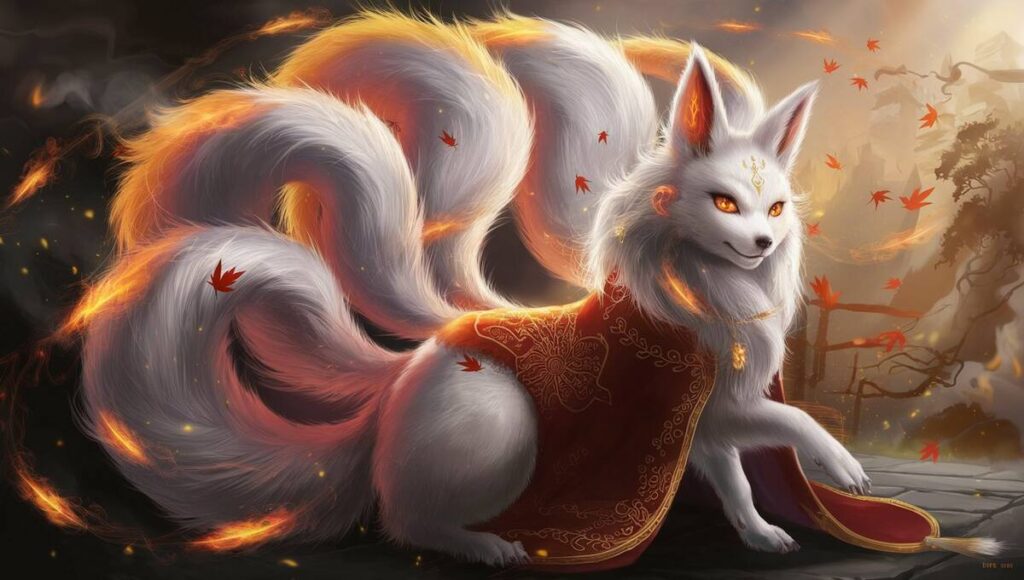
Kitsune are known for their playful and endearing nature. These Cute Kitsune Names capture their whimsical charm, perfect for a character that radiates joy and brings a sense of lighthearted fun wherever they go.
- Yui Hana – “Tie and flower,” symbolizing a Kitsune who brings people together with beauty and grace.
- Mio Yuki – “Beautiful cherry blossom and snow,” representing delicate beauty and purity that stands out in all seasons.
- Aiko Sora – “Love and sky,” symbolizing a sweet, uplifting spirit that spreads love and light wherever they go.
- Rin Neko – “Companion and cat,” reflecting a playful and curious Kitsune, always bringing joy with a mischievous smile.
- Emi Sakura – “Beautiful blessing and cherry blossom,” representing joy, beauty, and a nurturing spirit that blossoms in every season.
- Hana Kaze – “Flower and wind,” symbolizing a free-spirited, delicate Kitsune who dances through life with a gentle breeze.
- Chiyo Midori – “Thousand generations and green,” reflecting timeless charm, growth, and a close connection to nature’s vitality.
- Kiko Ame – “Hope and rain,” symbolizing a refreshing and nurturing spirit, bringing peace and renewal in every season.
- Nana Hoshi – “Seven and star,” representing a sparkling, twinkling Kitsune whose presence brings light and wonder.
- Miki Aozora – “Beautiful tree and blue sky,” symbolizing a lively, vibrant personality who brings clarity and joy to those around them.
- Rika Haru – “True fragrance and spring,” representing a sweet, refreshing spirit that brings warmth and growth wherever they go.
- Yuna Chibi – “Gentle and small,” symbolizing an adorable, endearing personality that captures the hearts of all they meet.
- Mai Kumo – “Dance and cloud,” reflecting a graceful and whimsical Kitsune who floats through life with elegance.
- Aya Hikari – “Colorful and light,” symbolizing a radiant and cheerful presence that brightens any room.
- Suzu Kawa – “Bell and river,” representing harmony and flow, a Kitsune whose presence soothes and uplifts all.
- Ami Hinata – “Friend and sunny place,” symbolizing a warm, welcoming spirit that makes everyone feel at home.
- Mio Fuyu – “Beautiful cherry blossom and winter,” representing quiet beauty, resilience, and serenity during life’s coldest moments.
- Nori Momo – “Doctrine and peach,” symbolizing sweetness, wisdom, and the ability to bring joy to all those they touch.
- Risa Hime – “Village and princess,” reflecting royalty, charm, and a gracious spirit that wins over hearts with every smile.
- Kira Tsubaki – “Glitter and camellia,” symbolizing sparkling beauty, grace, and strength in softness.
- Nana Yume – “Seven and dream,” representing a Kitsune who brings whimsical, magical dreams full of hope and joy.
- Maya Hoshiko – “True arrow and star child,” symbolizing a guiding spirit who leads others with their bright and confident energy.
- Sora Umi – “Sky and sea,” reflecting a free-spirited personality that is boundless, joyful, and full of adventure.
- Nori Mika – “Doctrine and new moon,” symbolizing a mysterious yet captivating personality that brings a new perspective to everything.
- Ami Yuki – “Friend and snow,” symbolizing an inviting, gentle nature that radiates warmth even in the coldest moments.
- Saki Airi – “Blossom and love,” reflecting beauty, affection, and a heart full of kindness.
- Tami Kiri – “Pine tree and mist,” symbolizing calmness, nature’s purity, and the ability to create a peaceful atmosphere.
- Riko Mori – “Jasmine child and forest,” representing purity, connection to nature, and an adventurous spirit at heart.
- Kimi Haruna – “Noble spring,” symbolizing the renewal of life, hope, and the gentle touch of spring’s breeze.
- Yuna Kimi – “Gentle and noble,” reflecting grace, dignity, and a soothing presence that brings peace to all who encounter them.
- Suzu Mai – “Bell and dance,” symbolizing rhythm, joy, and the playful energy of a Kitsune that dances through life.
- Hina Tsubaki – “Light and camellia,” representing quiet beauty, calm strength, and a gentle spirit that attracts admiration.
- Miku Sora – “Beautiful and sky,” symbolizing endless possibilities, freedom, and a bright, uplifting nature.
- Riko Hana – “Jasmine child and flower,” representing beauty, gentleness, and the fragrance of life’s simple joys.
- Tomo Hoshi – “Friend and star,” symbolizing a guiding light, a loyal friend, and the warmth they bring to those around them.
- Aira Mizuki – “Love and beautiful moon,” representing tenderness, elegance, and a calm but captivating presence.
- Yuki Hina – “Snow and light,” reflecting purity, clarity, and a personality that radiates brightness in dark times.
- Mina Kumo – “Green and cloud,” symbolizing growth, serenity, and the peaceful nature of a kind Kitsune who fosters life and peace.
- Fumi Aya – “Scholarly and colorful,” symbolizing an intellectual, vibrant spirit who always shares wisdom with a playful twist.
- Sora Mika – “Sky and new moon,” representing endless dreams, new beginnings, and the fresh perspectives a Kitsune brings.
Japanese Kitsune Names
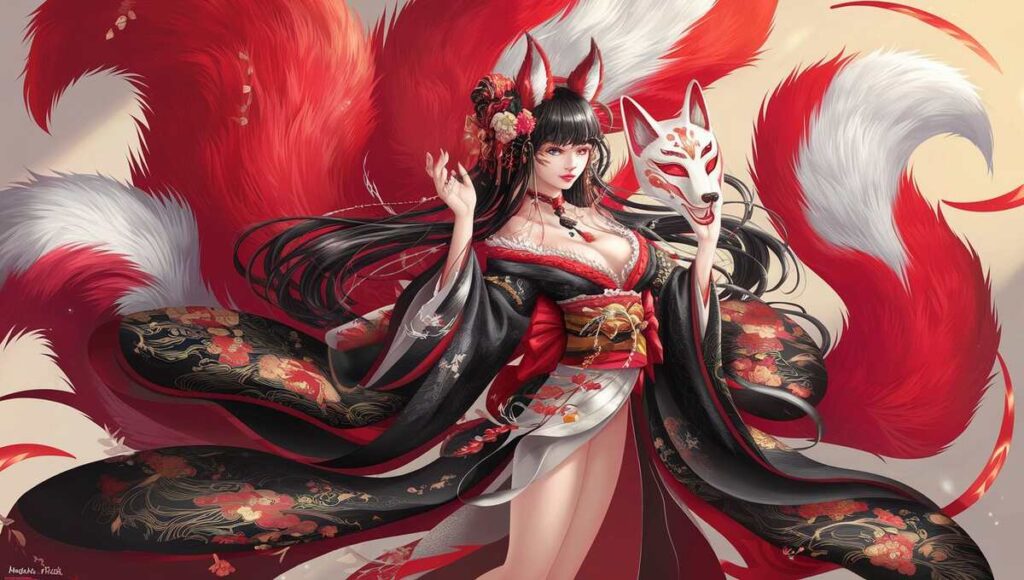
Kitsune are deeply intertwined with Japanese folklore and mythology. These Japanese Kitsune Names reflect their mystical qualities, blending elements of nature, beauty, and spiritual wisdom to bring your Kitsune character to life.
- Yuki – “Snow,” symbolizing purity, calmness, and the quiet beauty of winter.
- Hikari – “Light,” representing brightness, hope, and the power to guide others.
- Sora – “Sky,” symbolizing freedom, endless possibilities, and a boundless spirit.
- Aiko – “Beloved child,” representing love, affection, and a nurturing presence.
- Miko – “Shrine maiden,” reflecting grace, spirituality, and a deep connection to the divine.
- Kaito – “Ocean and wisteria,” symbolizing beauty, depth, and natural elegance.
- Riko – “Jasmine child,” symbolizing purity, innocence, and a sweet, delicate spirit.
- Haruki – “Spring and radiance,” representing renewal, hope, and the vitality of life.
- Yumi – “Archery,” symbolizing precision, focus, and a strong sense of direction.
- Keiko – “Blessed child,” reflecting happiness, fortune, and a kind-hearted nature.
- Hana – “Flower,” symbolizing beauty, grace, and a gentle, nurturing spirit.
- Tsubaki – “Camellia flower,” representing elegance, strength, and a timeless beauty.
- Ren – “Lotus,” symbolizing spiritual growth, purity, and inner peace.
- Shiro – “White,” reflecting innocence, purity, and simplicity in the face of complexity.
- Miyu – “Beautiful moon,” symbolizing serenity, quiet beauty, and mystical energy.
- Ami – “Friend,” representing loyalty, compassion, and the power of close relationships.
- Rin – “Dignity,” symbolizing grace, poise, and strength of character.
- Saki – “Blossom,” representing new beginnings, growth, and natural beauty.
- Yume – “Dream,” symbolizing hope, aspiration, and the power to create new realities.
- Fuyu – “Winter,” symbolizing resilience, endurance, and the ability to thrive in harsh conditions.
- Azami – “Thistle,” representing strength, protection, and the ability to stand strong in adversity.
- Kiyomi – “Pure beauty,” symbolizing grace, elegance, and the purity of heart.
- Nao – “Honest,” reflecting integrity, truthfulness, and a straightforward nature.
- Ichika – “First flower,” symbolizing new beginnings, hope, and the beauty of a fresh start.
- Kohana – “Small flower,” representing delicate beauty, grace, and a gentle, nurturing spirit.
- Mao – “Dance,” symbolizing joy, energy, and the fluid movement of life.
- Natsumi – “Summer beauty,” reflecting warmth, charm, and the vibrant energy of the season.
- Tatsu – “Dragon,” symbolizing power, wisdom, and a protective nature.
- Sakiya – “Blooming flower,” representing growth, beauty, and the flourishing of potential.
- Kiyori – “Pure lily,” symbolizing grace, elegance, and a spiritual connection to nature.
- Rinako – “Cold child,” representing calmness, tranquility, and quiet strength.
- Aozora – “Blue sky,” symbolizing freedom, vastness, and the expansive potential of the future.
- Seiji – “Lawful and righteous,” representing justice, integrity, and the pursuit of fairness.
- Kazumi – “Harmonious beauty,” symbolizing balance, grace, and peaceful energy.
- Tomo – “Friend,” symbolizing loyalty, kindness, and the deep connection shared with others.
- Mikazuki – “Crescent moon,” representing mystery, subtle power, and quiet influence.
- Hoshiko – “Star child,” symbolizing guidance, hope, and the light in the darkness.
- Airi – “Love and hope,” representing affection, optimism, and the joy of bringing light into the world.
- Eri – “Blessed prize,” symbolizing a gifted, fortunate spirit with a sense of purpose and destiny.
- Nozomi – “Hope,” representing dreams, optimism, and the ability to see the potential in all things.
Check Out Our Collection Of Kitsune Name!
How to Choose the Right Name for My Kitsune Character
- Reflect Their Personality: Pick a name that matches your Kitsune’s traits, whether they are playful, wise, or protective.
- Use Meaningful Elements: Choose names inspired by nature or elements like fire, water, or wind to reflect their magical abilities.
- Consider Folklore: Look to traditional Japanese Kitsune names for authenticity and deeper meaning.
- Match the Role: A protector Kitsune might have a name symbolizing strength or wisdom, while a trickster could have a more playful name.
Kitsune Name Generator
Looking for the perfect name for your Kitsune character? Our Kitsune Name Generator is here to help! With a mix of mystical qualities and cultural significance, this tool generates unique and meaningful names to bring your Kitsune to life in an instant.
Kitsune Name Generator
Conclusion
The perfect Kitsune name is key to bringing your character to life. A well-selected name captures the essence of your Kitsune’s personality, powers, and role in the story. Whether you need a playful trickster or a wise protector, the right name adds depth and magic.
Our Kitsune Name Generator makes finding that perfect name easy and fun. With names inspired by Japanese folklore, each one carries meaning and mystique. Start your creative journey today and let the right name shape your Kitsune’s story!
Frequently Asked Questions About Kitsune Names
What is a good kitsune called?
In Japanese folklore, a good Kitsune is often referred to as a Zenko. Zenko Kitsune are benevolent fox spirits known for their wisdom, purity, and protective nature, often bringing blessings and good fortune to those they serve.
What are good names for kitsunes?
Good Kitsune names reflect the character’s magical qualities. Names such as Hikari (Light), Sora (Sky), and Kiyomi (Pure Beauty) embody traits of wisdom, protection, and grace, ideal for benevolent Kitsune characters.
What are the names of the 13 kitsunes?
The 13 most famous Kitsune names include Tamamo-no-Mae, Kuzunoha, Shiragiku, and Zenko. These names are rooted in Japanese mythology and represent legendary Kitsune with unique powers and cultural significance.
What is the significance of a kitsune’s name in Japanese folklore?
In Japanese folklore, a Kitsune’s name is often symbolic, tied to their abilities, nature, or role in stories. A name can signify magical powers, like shape-shifting or wisdom, and reflect the Kitsune’s connection to spirits or nature.
Can I use a traditional Japanese kitsune name for my character?
Yes, you can use traditional Japanese Kitsune names for your character, adding authenticity to their backstory. Ensure the name aligns with the character’s personality or traits for a more immersive experience.
Are there specific elements associated with kitsune names?
Kitsune names often incorporate natural elements such as wind, water, fire, and earth. They can also reference celestial bodies like the moon and stars, linking the Kitsune to the elemental forces and supernatural realms.
How do kitsune names reflect their mythical abilities?
Kitsune names reflect their mythical abilities by representing the elements or qualities they possess. For example, Raikou (Thunder Light) reflects their control over lightning, while Yukino (Snow) suggests their power over ice and cold, highlighting their supernatural traits.

Alexander Smith is an accomplished blogger with years of experience in crafting engaging and insightful content. Known for his expertise and passion for storytelling, Alexander brings a unique perspective to Fascinate Names, captivating readers with his thoughtful analysis and fresh ideas. His extensive background in digital media and writing makes him a valuable voice in the blogging community.

